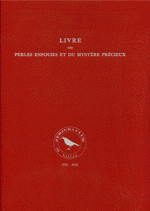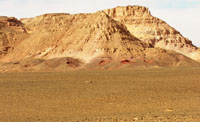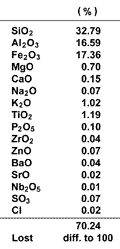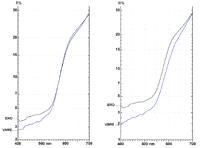|
Livre des perles (11-2008) |
Très rare!
Livre des perles enfouies et du mystère précieux au sujet des indications des cachettes, des trouvailles et des trésors Édition limitée, numérotée à 100 exemplaires, publiée en 2008 par les soins de‘Zerzura Club’ et‘Pyramids’. Seulement 50 exemplaires sont disponibles au prix de 68,00€ chacun. 250 pages plus deux annexes de 55 et 32 pages, trois cartes. Tiré de la version française de 1907, publiée et traduite de l’arabe par Ahmed Bey Kamal, Membre de l’Institut Égyptien, Conservateur au Musée Égyptien du Caire. Breve presentazione dell'opera
Further remarks on the ochre quarries in the Western Desert, Egypt A complement to our paper The Lost Ochre Quarries of king Cheops and Djedefre in the Great Sand Sea (Western Desert of Egypt) published in Sahara volume 16, 2005, p. 121-127, Pl. G-P, and to Dr Carlo Bergmann's remarks (Carlo Bergmann). Introduction Among the evidence for ancient industrial activities, the remains of quarries for soft rock materials are the most difficult to identify. When the quarried materials are hard, such as building stones, ornamental stones or marbles, the marks left by chisels, wedges, sawblades and picks provide a certain evidence. Where the materials concerned are soft or friable, such as brick or pottery clays, bleaching and degreasing earths, pozzuolans, colour earths and siliceous sands, in the temperate zone the quarrying marks disappear more or less rapidly because of erosion, and the working faces tend to slide down, fill up with water and debris and level out with the surrounding surface. As a consequence, it can be difficult to distinguish a natural outcrop from a working face, especially if the mining methods are not known and one has no familiarity with ancient and present-day quarry workings. In the case of Cheops' and Djedefre's ochre quarries, the identification of the various working faces is easier, considering their excellent preservation due to three elements, namely: 1) a dry climate, though windy and with a high range of temperature, 2) a short working period, for obvious logistic problems, and 3) lack of later quarrying activity, that would have compromised the interpretation of the ancient stages. Remarks on mining The ochre beds belonging to the Abu Ballas formation (formerly ascribed to the Sabaya formation) are near horizontal and very gently dipping toward NNW. On the topographical surface the red outcrops follow the foot of the main hills. The general direction of the bedding is WSW-ENE, but locally the outcrops are exposed by cuts with a NW-SE direction. In November 2005 we travelled 7 kilometres to ENE along the outcrops and did not observe any further working mark. We also observed that more scattered red beds occur towards the east, but we did not have time to visit them. The worked area has an extension of 3 by 2 kilometres. In our deposit, red ochres generally form low hills with gentle slopes, approximately 20-m high over the undifferentiated gravel plain. Their tops are flat, protected as they are by a layer of dark grey sandstone quite resistant to erosion. The outcrop is dissected by small and short deeply dug valleys. All the slopes are covered with continuous levels of coarse dark debris mostly hiding red sediments. In order to better work the material, that is anyway rather easy to quarry, miners had to apply a sequence of necessary operations, unchanged through centuries. The various steps of human activity are still so perfectly identifiable on the ground that the quarries seem to have been abandoned just a few years ago, as the photographs taken by G. Negro in February 2003 and by G. Negro, R. Serra, M. Di Martino and M. Morelli in November 2005 show. If we try to adapt to our ochre deposit the three ordinary steps required to start the open-cut mining, we can verify if a) they have been applied and b) some evidence exists. 1)Acknowledgement of the richest levels, the amount of useful mineral and the most opportune areas to carry out the works, trying to avoid valley floors. 2)Surface cleaning of the deposit. All the waste and capping must be removed to win the mineral. In our deposit, the large number of works show that cleaning has always been carried out and the removed pebbles have been dumped immediately downhill. Locally, the difference between cleaned and uncleaned outcrops and erosion phenomena is obvious. 3)Development of the most suitable mining method, not necessarily the same all over the deposit. In our deposit, the recovery of the ochre is based upon drifting work and trenching across. The blanket vein is removed step by step. This is evidenced by the vertical edges, sharp corners, roughly cut steps.
I. Almost horizontal benches, formed by the progressing works; II. Sharp cut with surrounding uncleaned slopes; III. Continuity between cleaned uphill slope and uncleaned downhill slope; IV. Few digging marks; V. Well marked net of interconnected paths and strongly trampled areas. Due to the friable nature of the material itself, tool marks are only visible in few cases, problably because they are hidden by the later fall of debris. A)Once the blanket 'vein' is identified, a two-metres-high and ten-metres-wide drift is cut into the slope. Remarks on the ochre quality
We submitted a sample of red ochre of the ancient quarries to the largest Italian company dealing in colour earths, Dolci di Mario Dolci e Figli snc di Verona (www.dolcicolor.it). In preparing pigments, the company's owners follow the age-old skills that so well served our painting tradition through centuries. Results are above expectations. Preliminary observations conducted by Giuliano Dolci indicate that: Conclusions To sum up, we can conclude that
(February 16th, 2007) For further details please contact us |
||||||||||||||||||||
|
|
|
||||||||||||||||||||
|
|
|
||||||||||||||||||||
|
|
|||||||||||||||||||||














